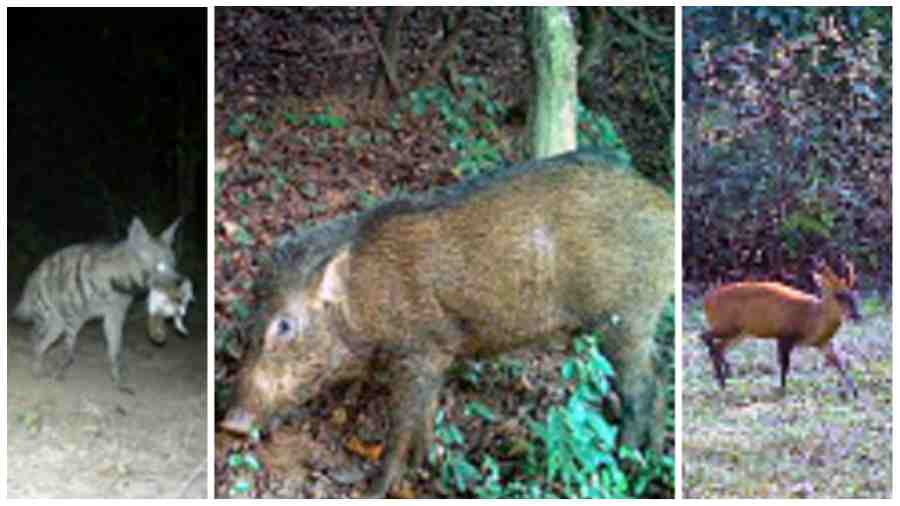Animals that do not hog the limelight have had their habitat and distribution documented for the first time in West Bengal.
A study, commissioned by the state forest department and done by the Zoological Survey of India (ZSI), has “gathered ecological data on the distribution and population assessment” of small mammals like Hyena (Hyaena hyaena), Indian Wolf (Canis lupus pallipes), Golden Jackal (Canis aureus) and Wild Boar (Sus scrofa) in the forests of south Bengal, except the Sunderbans.
The study, under the West Bengal Forest and Biodiversity Conservation Project, was funded by Japan International Cooperation Agency. It commissioned in 2019 and its report was tabled last year. It was delayed by a few months because of the pandemic.
The findings of the study were recently shared with this newspaper by a forest official.
Trap cameras kept for around 500 nights as part of the study captured 20 images of hyenas and seven images of wolves, the first time these animals were scientifically documented in the state.
“The population of these species is undocumented and the extent of their distribution is largely anecdotal. The study is the first step to plug that gap,” said a forest official.
A team of ZSI researchers spent a significant time between 2019 and 2021 in the forests of districts like Purulia, Jhargram, Paschim Medinipur and Bankura.
The study made use of all the tools available in recording and identifying wildlife, including sign surveys, questionnaire interviews, camera trapping, ecological modelling using remote sensing, and GIS and non-invasive genetics (DNA analysis of faecal samples).
“In three districts of Purulia, Bankura and Jhargram, camera traps were installed into 4X4sqkm grids. Based on the species distribution modelling, an intensive study area was identified, i.e. one range of Kangsabati North forest division, six ranges of Purulia forest division, four ranges of Kangsabati South forest division, three ranges of Bankura North forest division, six ranges of Bankura South forest division and three ranges of Jhargram forest division were covered for the intensive camera trapping,” says the executive summary of the report.
The key findings:Distribution
• Zone-wise evaluation suggested Bankura has the maximum area (3,040sq km) identified as “highly suitable” for Indian wolf, followed by Paschim Medinipur with 2,557sq km.
• Purulia has 3,022sq km of highly suitable habitat for striped hyena, Bankura has 597sq km and Paschim Medinipur 329sq km.
• The district-wise encounter rate (per kilometre) of Indian wolf, based on mainly sign (scat samples), was highest in Purulia at 0.25. It means there is a chance of spotting one sample every 4km.
• For striped hyena, the rate was highest in Purulia, at 0.05, followed by Bankura at 0.02.
• Hooghly topped the number for golden jackal with 0.80 and Bankura for wild boar with 0.45.
Camera images
• In 486 nights the camera traps were in action, the number of images was 20 for striped hyena, seven for Indian wolf, 24 for wild boar and 56 for the golden jackal. The cameras could not click any image of leopard cats, also a subject of the study.
DNA study
• Of the five studied species, genetic data could be generated for only three (Indian grey wolf, golden jackal and wild boar). Based on the non-invasive DNA analysis, the study found 22 individuals of grey wolf, 40 individuals of wild boar and 18 individuals of golden jackal.
Conflict
• The Durgapur forest division recorded most conflicts involving wild boars. Conflicts involving wolves were mostly seen in Jhargram. Purulia’s Kangsabati North forest division topped the list of conflicts with hyenas.
• “Human-wildlife conflict cases were classified into three types, crop damage mainly caused by wild boar, livestock attack by Indian wolf and golden jackal, and human attack which was less frequent,” the report says.
Recommendations
• The major threats, according to the report, included “habitat loss and fragmentation, retaliatory killing, poor availability of natural prey species of predators such as hyena and wolf, killing of animals during the Shikar Utsav by tribal communities, lack of awareness among the local communities about the ecology and behaviour of the study carnivores species”.
“Before this study, we were unaware of the distribution and current status of these species in the forests of south Bengal. This is the first time we could map the distribution, were able to understand the abundance of the species and also map and model the human-wildlife conflict,” said Lalit Kumar Sharma, a scientist with the ZSI and one of the researchers involved in the study
